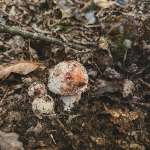Blusher - Amanita rubescens
At A Glance:
Blusher - Amanita rubescens
Other names: The Blusher, Amanita Wridog, Warty Cap
Season: Summer, Autumn
Edibility: Edible, Caution
Fungi Type: Fungi With Gills, Mycorrhizal
Frequency: Very Common
Habitat: Deciduous woodland, Coniferous woodland, Hedgerow
Average width and height: w: 50 - 150mm h: 80 - 120mm
Key Features:
- Slowly discolours pink when damaged
- Pink discolouration visible - usually around insect nibbles
- Movable off-white, grey or pink tinted spots
- Ring on stem with grooves on top
Despite many guides claiming this fungi is not for the novice forager, The Blusher is, with a careful approach, one of the easiest to identify thanks to it’s obvious set of defining characteristics, and makes for a tasty addition to the pan. This is a highly variable species in appearance, however once you’ve found a few, a glance is often enough to ID, even from the Panthercap. See my article here on the first foraged fungi I ever ate:
Table of Contents
Habitat/Season
Habitat: Deciduous woodland, Coniferous woodland, Hedgerow
Season: Jun, Jul, Aug, Sep, Oct, Nov
The Blusher will grow almost anywhere there is a compatible mycorrhizal partner, so can be found in both coniferous and deciduous woodland, but also many other areas where partner species are present like hedgerows, field edges and even in gardens.
Cap/Flesh/Fruiting Body
Average cap size: 50 - 150mm
Cap shape: ovoid, convex, flat
Cap colour: light brown, red/brown, ochre
The appearance of The Blusher can vary greatly, but has some unmistakable overarching characteristics. The cap can be a light ochre, darker shades or a red brown…or a mix of all of them. It starts ovoid and becomes convex with maturity, finally flattening out.
The cap surface most commonly has many irregular off-white spots which are fairly easy to take off.
And then there is it’s namesake - the pink blush. This can be seen throughout in varying degrees. Often where insects have nibbled or other damage. The flesh will slowly turn a light pink when damaged.
Gills/Spore
Gill density: crowded
Gill colour: white, flecks of blush on old specimens
Gill attachment: free
Spore print: white
Spore shape: ellipsoidal, smooth
The gills are crowded and near white. They are free from the stem and can often have flecks of discolouration over them, particularly with older examples.
Stem/Ring
Sharing the same blushing features as its cap and gills, the stem is also most often white above the ring, and patchy with colour below. The base of the stem is swollen, and on very young species the universal veil can sometimes be seen. As they age, the stem becomes hollow and almost always riddled with insects.
The ring hangs, is almost always visible and has a grooved upper surface. However, this is fairly fragile and I’ve found examples that show no ring where it has fallen away.
Possible Confusions
The key characteristics of this fungi make it pretty unmistakable, however there are some species to bear in mind.
- The Panthercap is a poisonous species. It is fairly rare, has white spots, a smooth hanging ring (no upper grooves), and doesn’t have the reddening of the blusher.
Edibility/Taste/Smell
A good edible species. Must be cooked before eating. It has a great texture and when fresh has a pleasant mushroomy smell.
Notes
Etymology: ‘rubescens’ = reddening/blushing 1
Once called the Warty Cap.2
References
Mushrooms and other fungi of Great Britain & Europe - Roger Phillips
Mushrooms and Toadstools of Britain and Ireland - Blacks Nature Guides















